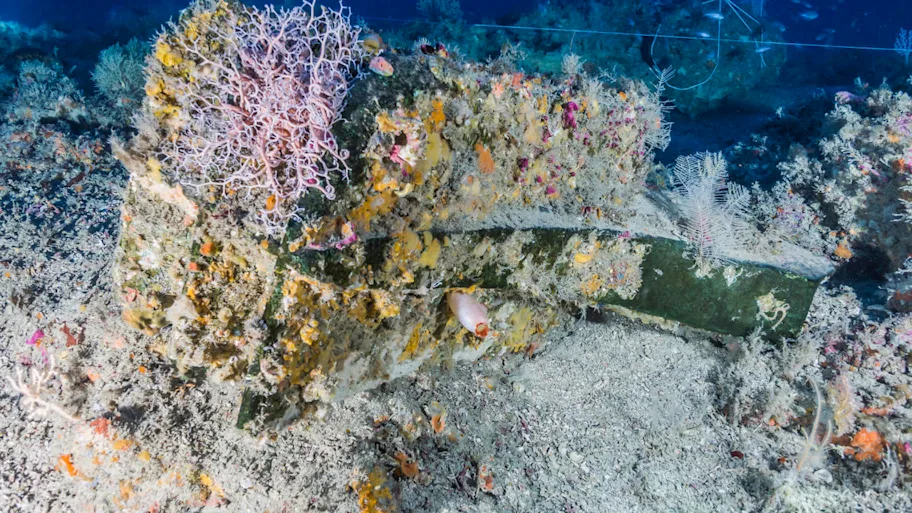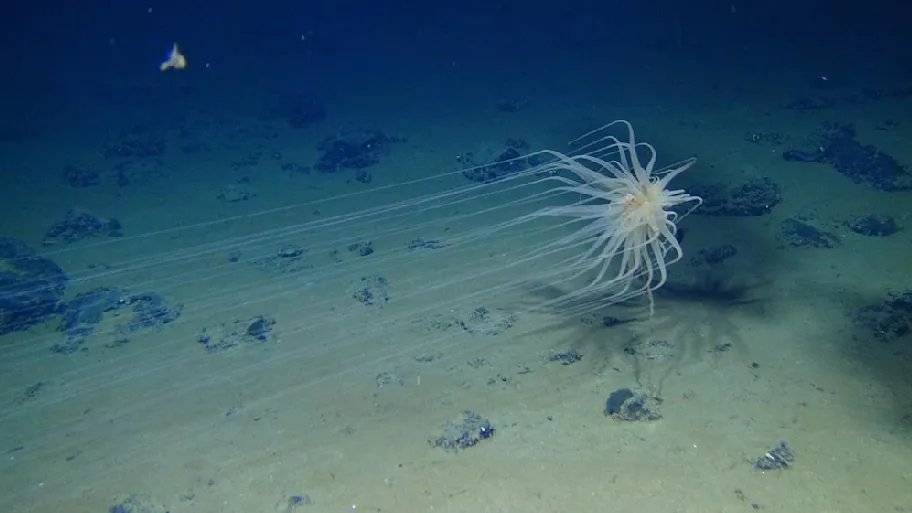
- Science News
- Featured news
- ‘Many kids go through a phase where they want to be a marine scientist. For me, it wasn’t a phase’
‘Many kids go through a phase where they want to be a marine scientist. For me, it wasn’t a phase’
by Patricia Albano/Angharad Brewer Gillham, Frontiers science writer

Patricia stands with remotely operated vehicle Deep Discoverer aboard NOAA Ship Okeanos Explorer during an expedition to explore the deep waters off the West Florida Shelf. Image: Patricia Albano.
Marine protected areas are meant to give threatened species space to live and thrive. But in a recent paper in Frontiers in Marine Science, Patricia Albano and colleagues showed that at least one protective area isn't capturing the range that endangered sharks use as they grow, leaving them vulnerable to commercial fishing. Albano, now the Internship Program Coordinator at the National Marine Sanctuary Foundation, NOAA Ocean Exploration, caught up with Frontiers to tell us a little about her career and her research, as part of our Frontiers Scientist series.
Albano's work focuses on shark ecology in an anthropogenic world and the associated conservation implications. After a BA and MSc from the University of Miami, she joined a project evaluating the efficacy of the De Hoop marine protected area (MPA) for threatened and endemic sharks off South Africa. Albano also dedicates her time to working in ocean education, supporting workforce development programs and efforts to increase diversity, equity, inclusion, and accessibility. In 2020, she joined the deep-ocean science community through a position with the National Marine Sanctuary Foundation, in support of NOAA Ocean Exploration.
What inspired you to become a researcher?
I was born and raised in south Florida. No one in my family worked in a science field, let alone marine science, but my parents were diligent about getting me to the water as often as possible. I think many kids go through a phase where they want to be a marine scientist when they first learn about the ocean. For me, it wasn’t a phase. I didn’t know what type of marine scientist I wanted to be, but I couldn’t see myself doing anything else. As a graduate student, I became intrigued about the use of MPAs as conservation management tools to support biodiversity preservation and positive societal impact. My work in South Africa was a perfect fit: a logistically challenging environment that demanded creativity and collaboration, and research questions that could inspire better protection for an area deeply revered by the local community.
Can you tell us about the research you’re currently working on?
My most recent research evaluated the movement and habitat utilization patterns of juvenile smooth hammerhead sharks in relation to a no-take MPA. We found that tagged sharks spent most of their time adjacent to the MPA, in an area of heavy commercial shark fishing. We made recommendations for management to reconsider the MPA’s shape and regulations to better protect this species. This research resulted from my time as a graduate student. Currently, I support NOAA Ocean Exploration’s outreach and education division. Our office is dedicated to exploring the unknown ocean, unlocking its potential through scientific discovery, technological advancements, partnerships, and data delivery. In my role, I coordinate efforts to train the next generation of ocean explorers through experiential learning opportunities. As we work toward closing gaps in our basic understanding of the ocean, I work within the agency and with external partners to support career education to help ensure the sustainability of ocean exploration into the future.
In your opinion, why is your research important?
MPAs are often presented as the most effective tool for ocean conservation. While they can be powerful, it’s important to prioritize sound science and community input as drivers of marine spatial planning. Without this, we risk the possibility of “paper parks” that fall short on their goals (eg, biodiversity conservation, preserving underwater cultural heritage). Research that provides biological and ecological guidance for spatial protection can help maximize the benefits that MPAs provide.
Download original article (pdf)
Are there any common misconceptions about this area of research? How would you address them?
For as many hours that I’ve spent in the field collecting data in extraordinary places, I’ve spent double that at my computer. While the idea of a marine science career may conjure images of SCUBA diving in sunny places for a living, in reality, the field is incredibly diverse in scope and includes people with a variety of interests, expertise, and perspectives. In my current role, I communicate this to students who may think marine science only involves field and lab work. Marine science jobs can also include long days in challenging conditions, frustrating roadblocks, and working in remote areas for long time periods. Yes, a marine science career can include unforgettable experiences, but we must remember that our responsibility is to bring findings back to shore and share them with relevant audiences.

Patricia Albano (front) and a team of shark researchers collect data from a large tiger shark in Miami, FL. Image: Paola Roldan.
What are some of the areas of research you’d like to see tackled in the years ahead?
I’m looking forward to seeing more research on the efficacy of MPAs as nature-based solutions to climate change, especially in the high seas and deep ocean. As the marine science community works together to meet international goals for ocean protection (eg, protecting 30% of the global ocean by 2030), we must do so with equitable, thoughtful, and intentional science. I’d love to see more research on how MPAs can be used as multi-faceted solutions to looming environmental issues.
How has open science benefited the reach and impact of your research?
Open science is valuable for expanding the impact of research within the scientific community and serves as a mechanism for lowering the barrier to inclusion in scientific discovery. This has been huge for my research in shark ecology. Given sharks’ threatened status, it’s vital to get research to decision-makers to support conservation. Open science also means folks outside the scientific community, such as students, teachers, and other stakeholders in a region where shark conservation is priority, can access our findings. Speaking from my experience working with the deep-ocean science and exploration communities, the benefit of open science and data accessibility cannot be understated. NOAA Ocean Exploration is committed to making data from our supported expeditions publicly available in a reasonable timeframe. This enables us to serve the scientific community and opens countless opportunities to use real data and discoveries to bring the deep ocean to life for students and the public through outreach and education.
If you have recently published your research with Frontiers and believe you have a story to tell, then you might feature as part of our new Frontier Scientists series! Send an email with the subject line ‘Frontier Scientists’ and your name to press@frontiersin.org , as well as details on what your most recent research was about.






